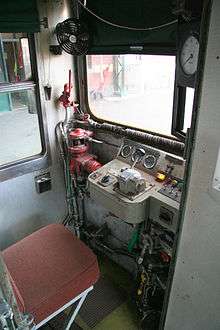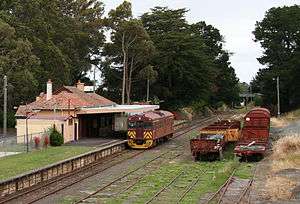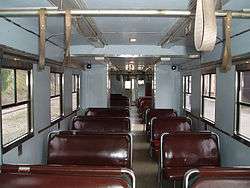Redhen railcar
| 300 / 400 Class Redhen | |
|---|---|
|
Two 400 class Redhens working a Belair line service in 1990 | |
|
Interior of Redhen 400 | |
| Manufacturer | South Australian Railways |
| Built at | Islington Railway Workshops |
| Replaced | South Australian Railways Brill railcar |
| Entered service | 1955–71 |
| Number built | 111 |
| Number preserved | 6 |
| Fleet numbers | 300–373, 400–436 |
| Operator(s) |
South Australian Railways State Transport Authority TransAdelaide |
| Specifications | |
| Car length | 20.0 m (65 ft 7 in) |
| Width | 3.05 m (10 ft 0 in) |
| Height | 4.27 m (14 ft 0 in) |
| Track gauge | 1,600 mm (5 ft 3 in) |
The Redhen Railcars were a self-propelled railcar built at the Islington Railway Workshops for the South Australian Railways between 1955 and 1971.
History
The Redhen railcars were the backbone of Adelaide’s metropolitan rail system between the late 1950s and the early 1990s. They operated on all the State Transport Authority routes, including several lines which are now closed to local trains (for example Bridgewater, Port Dock, Hendon and Wingfield).[1][2]
The first Redhens were introduced by the South Australian Railways in October 1955 to replace ageing suburban steam locomotive hauled trains in Adelaide. Construction of Redhen vehicles continued until 1971, when the latest examples were built to supersede 1920s-era diesel railcars.
TransAdelaide withdrew the last Redhens from regular service in October 1996, following delivery of a new fleet of 3000 class railcars. A number of Redhens have been preserved and are now operated by heritage and tourist railways.
Fleet details
The Redhens comprised two designs:-
- 300 class had a driving cab at one end of each railcar. These needed to run in 2-car formations.
- 400 class had driving cabs at both ends, and could be used as a single car when needed, or in multiple with other railcars to make up longer trains.
In addition, there were a number of unpowered trailer cars, the 820 and 860 classes. These had been modified from steam-era suburban carriages and were used with the Redhens between 1955 and 1987.
Construction
The Redhens were built in three batches. The overall design of the railcars was very similar, but there were differences in detail between the batches. Several railcars in the 300 class were re-numbered later in life, taking on the numbers of written-off or modified units.
The exterior of the units was always painted red, with variations in the colour of roofs and bogies over the years. The interior design and layout remained largely unchanged throughout their life. Some 300 class units were modified to provide guard’s accommodation or space for bikes when the 860 class trailers were withdrawn in 1987. This slightly reduced the seating capacity of these modified cars.
| 300 class | |||
|---|---|---|---|
| Unit numbers | Dates introduced | Weight (tonnes) | Seating capacity |
| 300–341 | 1955–58 | 40.7 | 91 |
| 342–361 | 1959–61 | 42.7 | 91 |
| 362–373 | 1968–70 | 41.9 | 84 |
| 400 class | |||
|---|---|---|---|
| Unit numbers | Dates introduced | Weight (tonnes) | Seating capacity |
| 400–419 | 1959–61 | 42.5 | 80 |
| 420–436 | 1968–71 | 42.5 | 78 |
Mechanicals
Each Redhen had two under-floor diesel engines and hydraulic transmission. Engines were sourced from either General Motors or Rolls Royce as follows:
| Redhen power plant | |
|---|---|
| Unit numbers | Engine Details |
| 300–341 400–419 | 2 x GM model 6/71–6086 inclined 2-stroke diesels 6.97 litre displacement. 163 kilowatts (219 hp) at 2100 rpm |
| 342–361 | 2 x Rolls Royce C6SFLH horizontal 4-stroke diesels with supercharger 12.17 litre displacement. 170 kilowatts (228 hp) at 1850 rpm |
| 362–373 420–436 | 2 x GM model 6/71–6086 inclined 2-stroke diesels 6.97 litre displacement. 157 kilowatts (211 hp) at 2100 rpm |
- GM and Rolls Royce engines were subsequently exchanged between cars in the interests of standardisation.
- All Redhens were equipped with twin disc hydraulic torque converters with reversing gearbox.
- Braking was by Westinghouse SEM electro-pneumatic air brakes.
History
Deployment

When first introduced, all the 300 class Redhens were formed as 3-car consists, comprising an 820 or 860 class trailer sandwiched between two powered 300 class railcars. In peak hours, two sets were coupled together to form 6-car trains. On rare occasions, at times of heavy traffic demand, trains of Redhens could be up to 9 cars long.
Instead of building trailer cars to work with the 300 class cars, the South Australian Railways chose to convert existing rolling stock. Initially, five 800 class trailers and nineteen 850 class trailers were converted, becoming the 860 class. These cars had been built in the mid-1940s as part of a plan to electrify Adelaide's suburban railways. After the 800/850 class trailers were converted, thirteen end loading suburban baggage cars were converted, becoming the 820 class trailers.
The 400 class were used as single cars on the main lines during the evenings and at most other times on lightly patronized services such as the Grange, Tonsley and Northfield lines. They were also used in multiple with other 300 or 400 class units.
Super Chooks
Following the introduction of the State Transport Authority’s new 2000 class railcars in 1980, two 300 class Redhens and an 860 class trailer were chosen for an experimental rebuild at the Regency Park workshops. Nos 300, 337 and 862 were modified in 1983 with new interiors, elevated cabs similar to the 2000 class.
The rebuilt cars were re-numbered 2301, 2302 and 2501 and nicknamed Super Chooks (a chook is a chicken in Australian vernacular). The exercise was not successful and no more Redhens were modified. The Super Chooks saw only limited passenger service and often 2301-2302 was sandwiched in between 2 400 class Redhens before they were withdrawn in 1992. The super chooks ran on the Yorke Peninsula lions club railway between wallaroo and bute.
Withdrawal
| Preserved Redhens (October 2016) | |
|---|---|
| Unit Numbers | Location |
| 321 400 875 | National Railway Museum, Port Adelaide |
| 334 364 405 412 424 428 824 | SteamRanger, Mount Barker |
| 2301 2302 2501 406 416 432 435 | Wallaroo currently for sale |
| 311 402 | Mornington railway (yet to Arrive) |
| 409 436 339 368 372 373 | Stored in various locations in South Australia Victoria & New South Wales 368 is an information car 436 had its interior burnt out |
All thirteen of the 820 class trailers were retired by December 1976 (these were wooden-bodied coaches and most had originally been built between 1912 and 1918). The corresponding 300 class Redhens were then coupled to a 400 class railcar to form 2-car trains (designated 300/400 class).
In 1987, the steel-bodied 860 class trailers were withdrawn and all the 300 class Redhens were reconfigured as 2-car trains, usually consecutively numbered pairs.
In 1987/88 the State Transport Authority introduced the first of its new fleet of 3000 class railcars, which were intended to replace the Redhens. As more 3000 and 3100 class railcars were delivered through the early 1990s, the Redhens began to be withdrawn and were gradually restricted to operating only during weekday peak hours. This was especially the case when driver-only-operation (DOO) was introduced in the early 1990s. The manual sliding doors made Redhens unsuitable for DOO and guards had to be retained to supervise passenger boarding and alighting.
Following the final delivery of 3100 class railcars, the last Redhens were withdrawn on 15 December 1996.[3]
Preservation

Whilst in service the Redhens were mechanically robust and reasonably reliable; they were attractive options for use on heritage and tourist railways after retirement. However, their age, and the increasing service time since overhaul, has affected their reliability in preservation. Some continue to operate on broad gauge lines in south-eastern Australia. Many have been broken up, but the first and last units and a few others still exist.[4][5][6][7]
The National Railway Museum have 321, 400 and 875 in preservation.[8]
The South Gippsland Tourist Railway purchased Redhens 311, 402 and 416 in 1993 but in 2016 when the SGR closed in 2015 the Mornington railway was allocated them in 2016
Model
SAR Model Co make's a HO model kit, Both the 300 and 400 cars are produced with both unpowered and powered kit versions. The powered kits are supplied with a SPUD power units. Available kits are: 300 class 2 car kit, 400 class single car kit, 300 and 400 class box set (1 of each type) they are sold in a wooden box.
References
- ↑ 300 Class Rail SA
- ↑ 400 Class Rail SA
- ↑ "Farewell Red Hens" Railway Digest February 1997 page 16
- ↑ Redhen Railcars 300 to 373 Chris' Commonwealth Railways Pages
- ↑ Redhen Railcars 400 to 436 Chris' Commonwealth Railways Pages
- ↑ SAR 820 Class Wooden Railcar Trailers Chris' Commonwealth Railways Pages
- ↑ 860 Class Steel Railcar Trailer Cars Chris' Commonwealth Railways Pages
- ↑ Red Hens return for a special weekend ABC News 29 November 2013
- McNicol, S (1981). STA Railcars. Railmac Publications. ISBN 0 949817 01 5.
- Australian Railway Historical Society Bulletin vol.26 no.576 (Oct 1985); vol.26 no.577 (Nov 1985); vol.26 no.578 (Dec 1985). ISSN 1449-6291
- Transit Australia (Journal of the Australian Electric Traction Association Inc.), pub. Transit Australia Publishing, Sydney. ISSN 0818-5204
![]() Media related to Redhen railcar at Wikimedia Commons
Media related to Redhen railcar at Wikimedia Commons


